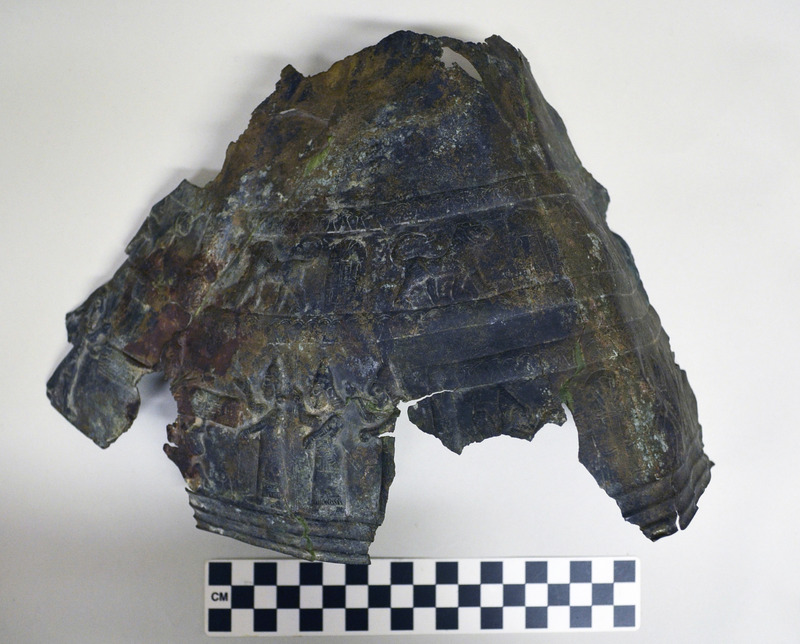Helmet
67-39-22
From: Iran (uncertain) | Turkey (uncertain)
Curatorial Section: Mediterranean
| Object Number | 67-39-22 |
| Current Location | Collections Storage |
| Culture | Urartian |
| Provenience | Iran (uncertain) | Turkey (uncertain) |
| Section | Mediterranean |
| Materials | Bronze |
| Description | Shape is much distorted, originally more or less conical. Broken (perhaps modernly) and subsequently mended with a hard green putty or plaster. Some ancient splits and cracks mended likewise. The edges are clearly broken rather than corroded away. Before cleaning covered with uneven patina of grainy green to black to almost bare metal. Now cleaned (not very successfully) to smooth dk. green to black with many areas of bare metal. Three narrow repousse ridges run along rim in band above which are two figured friezes in high relief, each topped by a repousse band with incised bud or pomegranate chain. In center of lower frieze (i.e. no doubt front of helmet) is a winged god facing R over crouching bull. Central part of this group is broken away and surrounded by reddish corrosion on R and above, so that whether god has a body and how he sits or stands on bull is unclear. Raised area just to R of break may indicate that he was seated; but just to L of break a curving incised line may be part of "sun-disc" which encircles god. Bearded, wears pointed helmet, R arm is outstretched with thumb up and hand open. Wings are simple elongated rectangles with incised wavy lines to indicate feathers. Before the bull on the groundline is the head and neck of a ram done only in incision -- meant to be either a rhyton or an indication of a slaughtered animal for the meal of the god. facing the god are three standing human figures facing L. Each wears a long robe and helmet, arms extended with R pointed up an dL down. From the L hand of first two figures descends a vertical incised wavy line, probably representing a libation being poured. (but NB: hands appear empty). R hand of first figure seems empty. Two parallel incised lines extend down from his L hand diagonally to his robe: the beginning of an unfinished spear? (or could this be the other side of a ribbon that he holds?). From the backs of the first two figures extend scabbards. The second and third figures are posed just like the first except that the second holds a spear vertically in R hand, third holds a bucket in L hand. (4 punched dots where handle of bucket meets rim must indicate some sort of handle attachment) Third figure also has ring shaped object in R hand. Helmets are conical but spread to flat platform at top; dec.: row of punched dots near bottom and 2 incised lines at narrowest point. Ankle length robes are fringed at the bottom and along diagonal line under one arm. the first has a band of zig-zags set off by 2 incised lines above and below, topped by a row of rosettes consisting of three punched circles. those men are clean shaven. To L of god stands bearded divinity (?) wearing a cutaway kilt and holding up a three branched object in his raised R hand and small circular object in his L. He apparently has no moustache besides his beard and is bareheaded. To his L just beyond the broken edge extends a single upraised hand holding a pomegranate (?). Behind the last man on the R (of the group of 3) begins a rectangular area set apart by a bud band which is not preserved as far as its R side. Within are two sacred trees in the form of tongue shaped stelai with incised dec., faced on either side by a winged divinity (though farthest right one has to be restored). The stelai have an incised central vertical member topped by a palmette; on either side of this are two levels of branch-like motifs separated by pairs of incised lines. The vertical part is filled with two lines of small pinched circles divided by narrow hatched bands at top, bottom and middle. The winged figures wear the cutaway fringed kilts and rounded conial hats or helmets, the one on the L rather more pointed than the others, each decorated with two or three rows of punched circles. each figure holds a bucket in L hand (not present for a L figure) and extends R hand toward stelai. The upper frieze is divided by a vertical repousse rib terminating in a lion's head in high relief seen from above just above the god's head and slightly overlapping the bud band (right in center of helmet). Rib seems to gradually flatten out at the top and disappear. On R a lion faces center, followed by a stela then lion facing R, then stela, then lion facing L, then fragment of lion facing R. On L only a single lion facing R is present. Lions are panther-like and sketchily drawn. |
| Height | 20.95 cm |
| Width | 29.8 cm |
| Thickness | 0.1 cm |
| Credit Line | Purchased from Hesperia Art, 1967 |
Report problems and issues to digitalmedia@pennmuseum.org.


